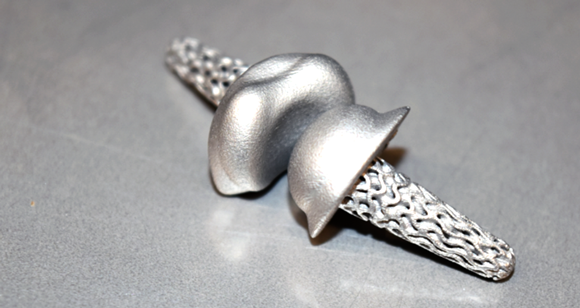Additive Manufacturing and AI enable bespoke finger implants
December 7, 2022

Five Fraunhofer institutes – Research Institution for Additive Manufacturing Technologies IAPT, the Institute for Ceramic Technologies and Systems IKTS, the Institute for Toxicology and Experimental Medicine ITEM, the Institute for Mechanics of Materials IWM and the Institute for Digital Medicine MEVIS – have developed a bespoke additively manufactured joint implant, intended to restore the mobility of fingers with damaged joints in a project known as FingerKIt.
At the moment, if a finger joint loses its function due to accident or injury, the treatment methods are limited. In most cases, the joint is fused, but this results in severe restrictions in the patient’s day-to-day life; silicon or basic standard implants can either become loose quickly, are only available in certain sizes, or restrict movement. The goal of FingerKIt was to create an automated process which would allow personalised finger joint implants to be produced from metal or ceramic in a rapid, safe and certified process.
The scientists at Fraunhofer MEVIS started off by developing a piece of AI-based software which is able to turn two-dimensional X-ray images into three-dimensional models of the finger bones and correct any malposition of the fingers. The researchers from Fraunhofer IAPT then used AI to derive the individual implant design from the finger model and send it for Additive Manufacturing. Since the structures involved are very fine and delicate, the scientists selected metal Binder Jetting. The implants then underwent a sintering process. At Fraunhofer IKTS, the implants are produced using near-net shape manufacturing. Fraunhofer ITEM is taking care of questions regarding the biological compatibility and certification of the implants, while Fraunhofer IWM is responsible for the simulation of the mechanical loads.
“The AI-based calculation of a three-dimensional implant design from 2D templates such as X-ray images is completely new and is now patent pending,” stated Dr Arthur Seibel, head of the Part Design group at Fraunhofer IAPT.

Dr Philipp Imgrund, head of the AM Process Qualification department at Fraunhofer IAPT, added, “Process engineering is special too. As the structure of the implant shaft is very delicate, we have chosen to use the metal Binder Jetting 3D printing method for titanium. This method allows for an extremely precise production of the small, complex implants and also enables us to structure the surface of the shaft in such a way that it grows into the bone more effectively. Furthermore, this minimises the finishing work required for the joint surfaces, which need to be as smooth and frictionless as possible.”
Through the use of automated model creation and Additive Manufacturing, this production process also saved time. According to the researchers’ initial calculations, it may be possible to save up to 60% of the time normally required from identifying the need for an implant to fitting it in the patient. This means that the process could be completed within a matter of days, resulting in shorter hospital stays and, thus, lower costs.
The technological development within the FingerKIt project has now reached a stage where the product could be made ready for the market in collaboration with a partner from the medical engineering sector. The AI-based design creation and the manufacturing process work, and exhibitable implants have already been produced. The next step is to obtain the necessary approval.
In future, Fraunhofer anticipates that these positive results will enable users be to provide effective treatment for complicated cases such as severely bent fingers, missing bone parts or very small joints.
















